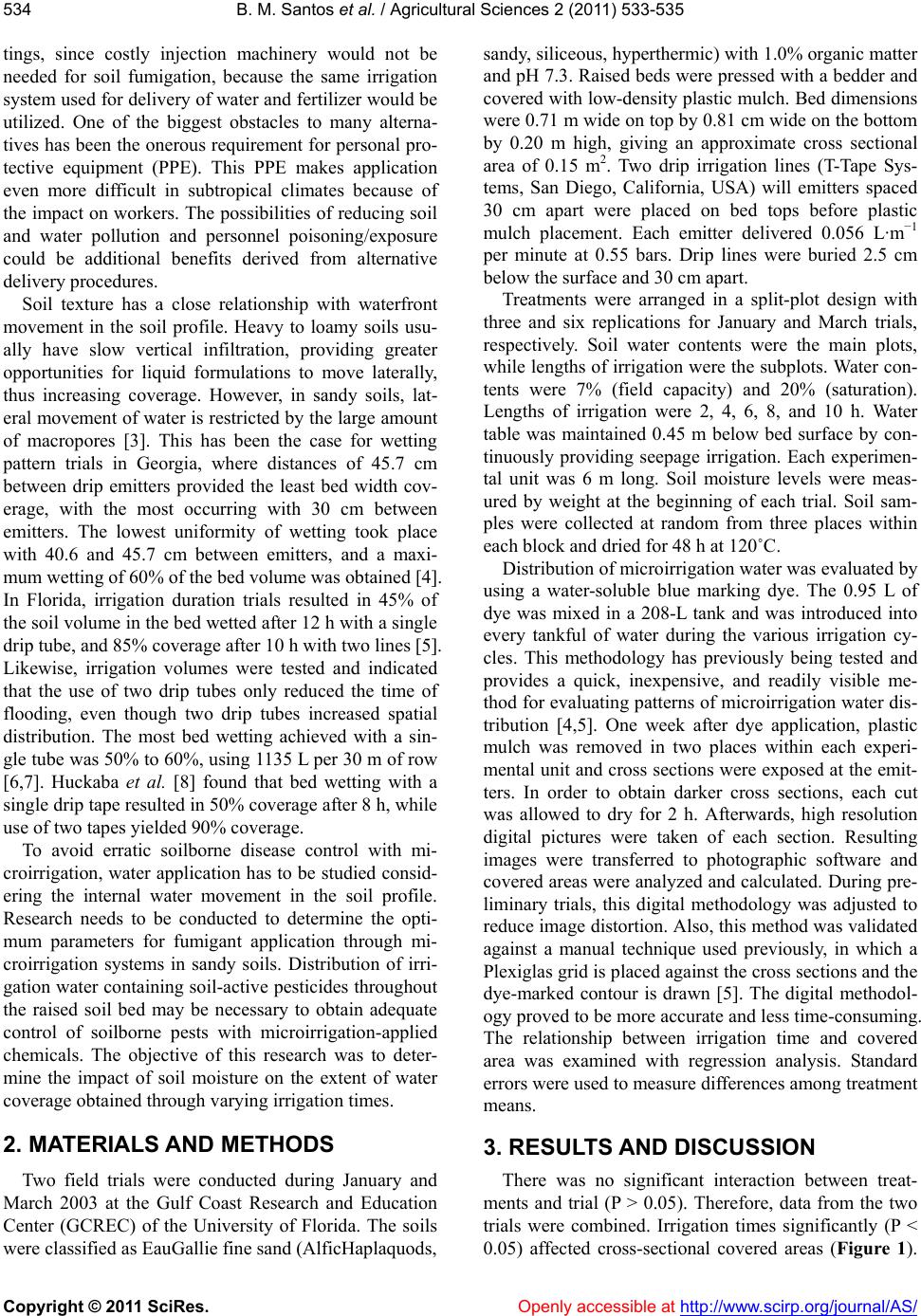
B. M. Santos et al. / Agricultural Sciences 2 (2011) 533-535
Copyright © 2011 SciRes. Openly accessible at http://www.scirp.org/journal/AS/
534
tings, since costly injection machinery would not be
needed for soil fumigation, because the same irrigation
system used for delivery of water and fertilizer would be
utilized. One of the biggest obstacles to many alterna-
tives has been the onerous requirement for personal pro-
tective equipment (PPE). This PPE makes application
even more difficult in subtropical climates because of
the impact on workers. The possibilities of reducing soil
and water pollution and personnel poisoning/exposure
could be additional benefits derived from alternative
delivery procedures.
Soil texture has a close relationship with waterfront
movement in the soil profile. Heavy to loamy soils usu-
ally have slow vertical infiltration, providing greater
opportunities for liquid formulations to move laterally,
thus increasing coverage. However, in sandy soils, lat-
eral movement of water is restricted by the large amount
of macropores [3]. This has been the case for wetting
pattern trials in Georgia, where distances of 45.7 cm
between drip emitters provided the least bed width cov-
erage, with the most occurring with 30 cm between
emitters. The lowest uniformity of wetting took place
with 40.6 and 45.7 cm between emitters, and a maxi-
mum wetting of 60% of the bed volume was obtained [4].
In Florida, irrigation duration trials resulted in 45% of
the soil volume in the bed wetted after 12 h with a single
drip tube, and 85% coverage after 10 h with two lines [5].
Likewise, irrigation volumes were tested and indicated
that the use of two drip tubes only reduced the time of
flooding, even though two drip tubes increased spatial
distribution. The most bed wetting achieved with a sin-
gle tube was 50% to 60%, using 1135 L per 30 m of row
[6,7]. Huckaba et al. [8] found that bed wetting with a
single drip tape resulted in 50% coverage after 8 h, while
use of two tapes yielded 90% coverage.
To avoid erratic soilborne disease control with mi-
croirrigation, water application has to be studied consid-
ering the internal water movement in the soil profile.
Research needs to be conducted to determine the opti-
mum parameters for fumigant application through mi-
croirrigation systems in sandy soils. Distribution of irri-
gation water containing soil-active pesticides throughout
the raised soil bed may be necessary to obtain adequate
control of soilborne pests with microirrigation-applied
chemicals. The objective of this research was to deter-
mine the impact of soil moisture on the extent of water
coverage obtained through varying irrigation times.
2. MATERIALS AND METHODS
Two field trials were conducted during January and
March 2003 at the Gulf Coast Research and Education
Center (GCREC) of the University of Florida. The soils
were classified as EauGallie fine sand (AlficHaplaquods,
sandy, siliceous, hyperthermic) with 1.0% organic matter
and pH 7.3. Raised beds were pressed with a bedder and
covered with low-density plastic mulch. Bed dimensions
were 0.71 m wide on top by 0.81 cm wide on the bottom
by 0.20 m high, giving an approximate cross sectional
area of 0.15 m2. Two drip irrigation lines (T-Tape Sys-
tems, San Diego, California, USA) will emitters spaced
30 cm apart were placed on bed tops before plastic
mulch placement. Each emitter delivered 0.056 L·m−1
per minute at 0.55 bars. Drip lines were buried 2.5 cm
below the surface and 30 cm apart.
Treatments were arranged in a split-plot design with
three and six replications for January and March trials,
respectively. Soil water contents were the main plots,
while lengths of irrigation were the subplots. Water con-
tents were 7% (field capacity) and 20% (saturation).
Lengths of irrigation were 2, 4, 6, 8, and 10 h. Water
table was maintained 0.45 m below bed surface by con-
tinuously providing seepage irrigation. Each experimen-
tal unit was 6 m long. Soil moisture levels were meas-
ured by weight at the beginning of each trial. Soil sam-
ples were collected at random from three places within
each block and dried for 48 h at 120˚C.
Distribution of microirrigation water was evaluated by
using a water-soluble blue marking dye. The 0.95 L of
dye was mixed in a 208-L tank and was introduced into
every tankful of water during the various irrigation cy-
cles. This methodology has previously being tested and
provides a quick, inexpensive, and readily visible me-
thod for evaluating patterns of microirrigation water dis-
tribution [4,5]. One week after dye application, plastic
mulch was removed in two places within each experi-
mental unit and cross sections were exposed at the emit-
ters. In order to obtain darker cross sections, each cut
was allowed to dry for 2 h. Afterwards, high resolution
digital pictures were taken of each section. Resulting
images were transferred to photographic software and
covered areas were analyzed and calculated. During pre-
liminary trials, this digital methodology was adjusted to
reduce image distortion. Also, this method was validated
against a manual technique used previously, in which a
Plexiglas grid is placed against the cross sections and the
dye-marked contour is drawn [5]. The digital methodol-
ogy proved to be more accurate and less time-consuming.
The relationship between irrigation time and covered
area was examined with regression analysis. Standard
errors were used to measure differences among treatment
means.
3. RESULTS AND DIS CUSSION
There was no significant interaction between treat-
ments and trial (P > 0.05). Therefore, data from the two
trials were combined. Irrigation times significantly (P <
0.05) affected cross-sectional covered areas (Figure 1).